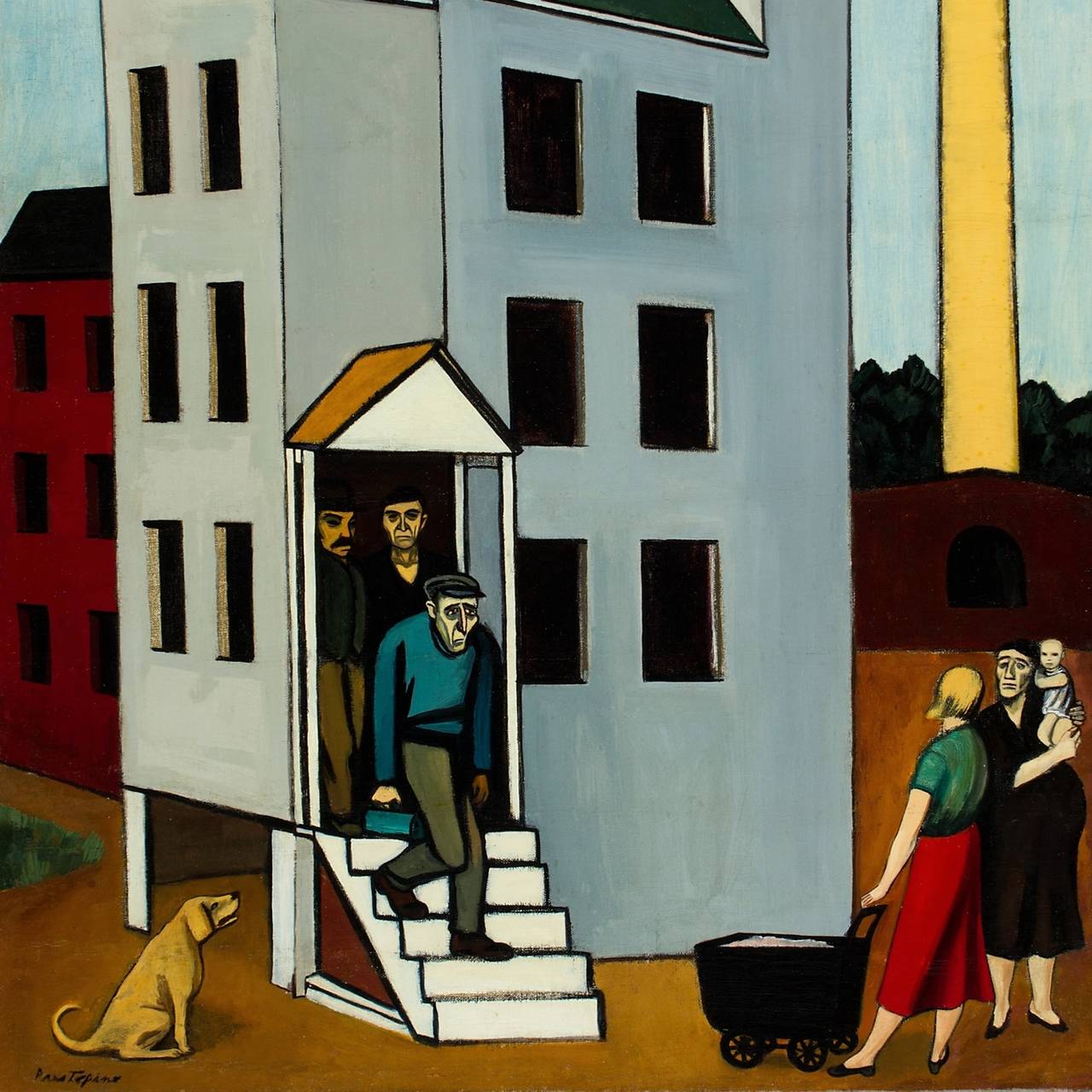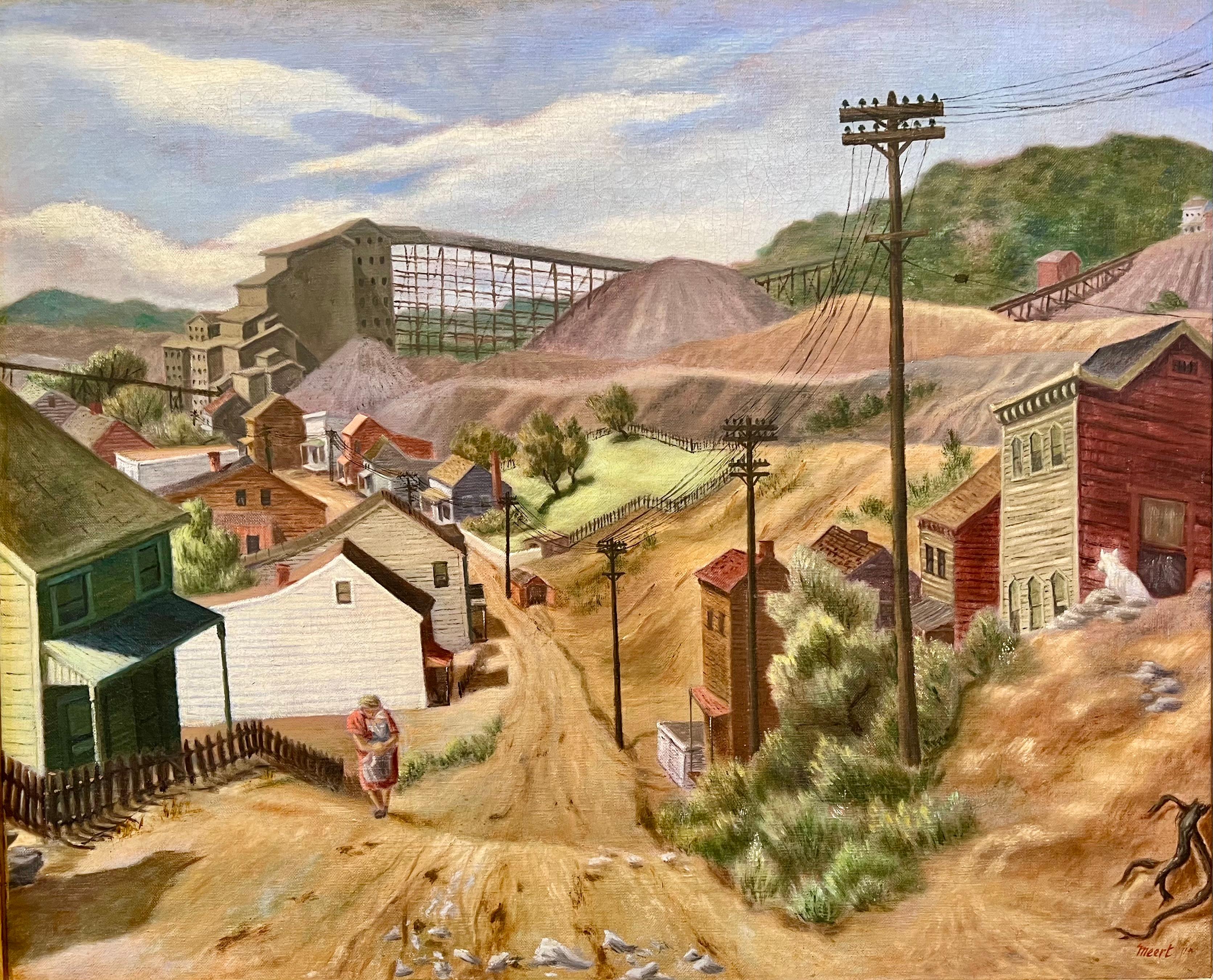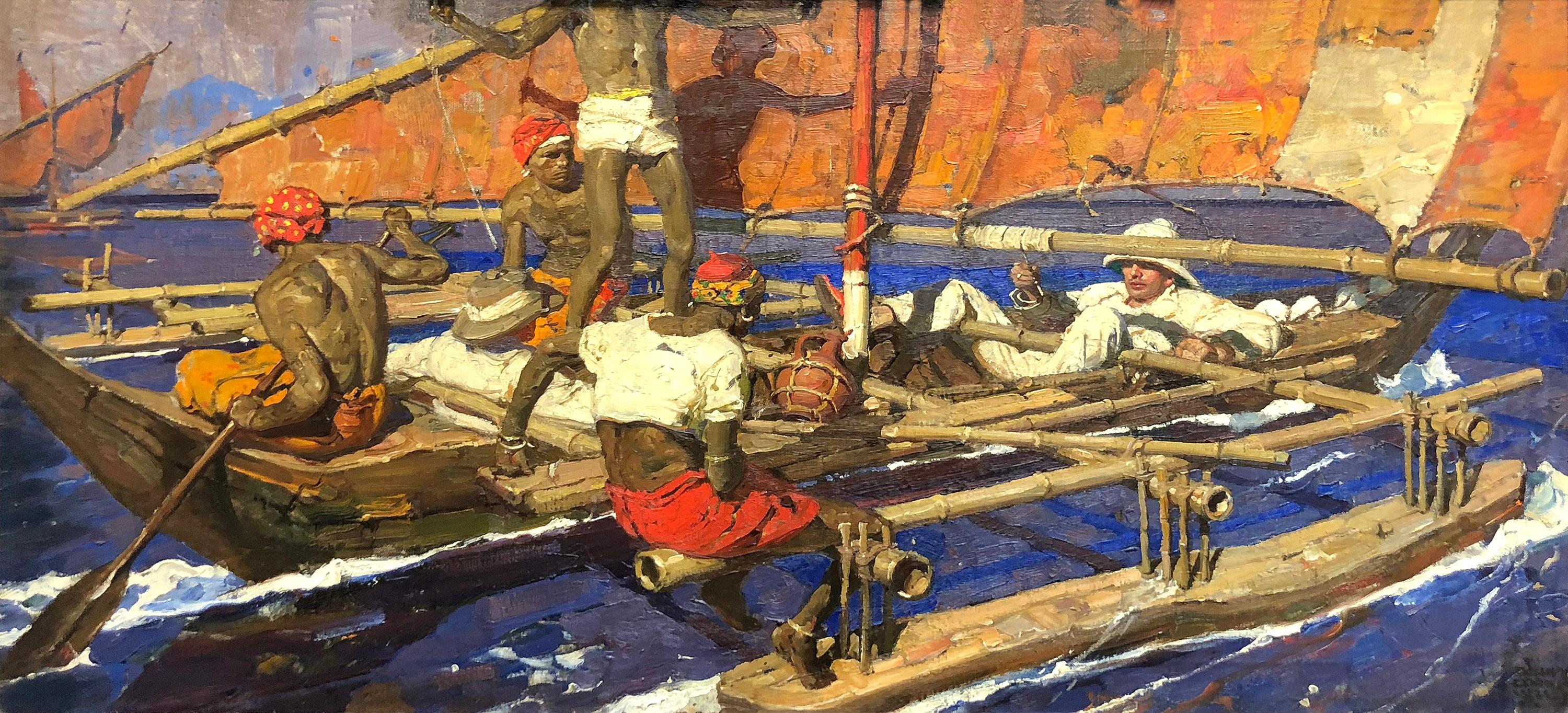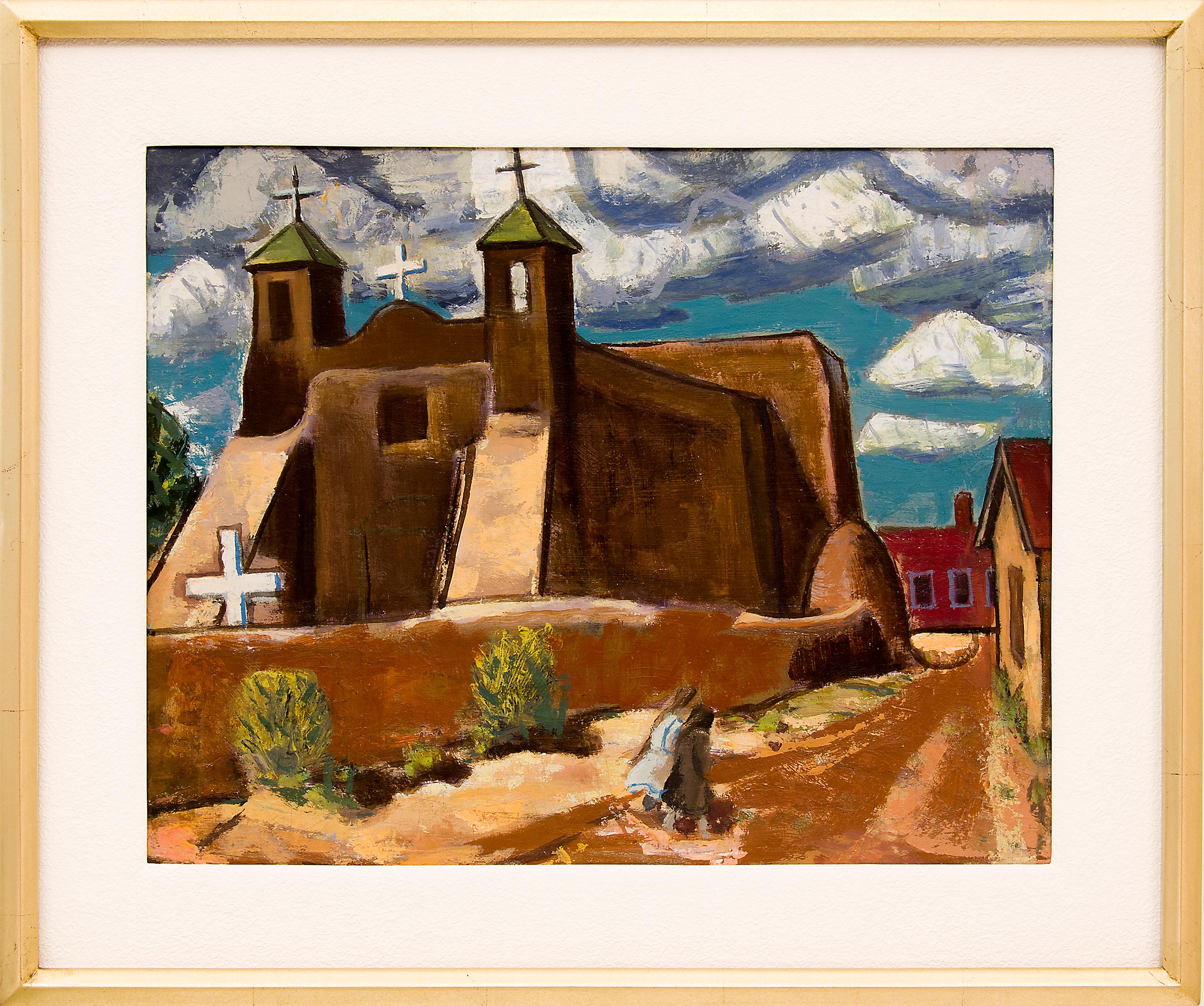Items Similar to "Little House Lambertville, Public Sale"
Want more images or videos?
Request additional images or videos from the seller
1 of 5
Joseph Barrett"Little House Lambertville, Public Sale"
About the Item
Jim’s of Lambertville is proud to offer this artwork.
Signed lower middle. Artist designed frame.
Joseph Barrett (b. 1936)
Joseph Barrett was born in Midland, North Carolina, in 1936 and studied at the Massachusetts College of Art in Boston and at the Tyler School of Art in Philadelphia. Barrett, now of Lahaska, Pennsylvania, has been painting his entire adult life. His favorite subjects include the landscape surrounding New Hope and many local landmarks often encompassing figures into his compositions. Barrett utilizes a heavy impasto and his palette bears similarities to that of Fern Coppedge and George Sotter. Barrett’s paintings are always found in unique and somewhat charming handmade frames designed by the artist and finished in metal leaf.
A living contemporary of the no longer living “New Hope School” impressionist painters, Joseph Barrett resides outside of New Hope above his old-fashioned antique shop and studio. Entering Barrett’s shop is like taking a step back in time. Inside this cluttered and dusty haven of treasures from the past, is a studio spanning only four by eight feet. This little studio, containing cans of old brushes and hundreds of used paint tubes, is reminiscent of something found in a turn of the century photograph. It is here that the Pennsylvania Impressionist tradition is still being carried on.
Sources: New Hope for American Art by James M. Alterman
- Creator:Joseph Barrett (1935, American)
- Dimensions:Height: 24 in (60.96 cm)Width: 24 in (60.96 cm)Depth: 2 in (5.08 cm)
- Medium:
- Movement & Style:
- Period:
- Condition:
- Gallery Location:Lambertville, NJ
- Reference Number:
About the Seller
5.0
Vetted Seller
These experienced sellers undergo a comprehensive evaluation by our team of in-house experts.
Established in 1997
1stDibs seller since 2014
36 sales on 1stDibs
Typical response time: 6 hours
- ShippingRetrieving quote...Ships From: Lambertville, NJ
- Return PolicyThis item cannot be returned.
More From This SellerView All
- "The Auction"By Robert SpencerLocated in Lambertville, NJJim’s of Lambertville is proud to offer this artwork by: Robert Spencer (1879 - 1931) One of the rarest and most important artists among the New Hope School, Robert Spencer was bor...Category
1910s American Impressionist Landscape Paintings
MaterialsOil, Canvas
- "Summer Picnic"By Joseph BarrettLocated in Lambertville, NJIllustrated in "Joseph Barrett, The Prime Years 1970s - 1990s", pg. 5 #005 Jim’s of Lambertville is proud to offer this artwork by: Joseph Barrett (1936 – ) Joseph Barrett wa...Category
Late 20th Century American Impressionist Landscape Paintings
MaterialsOil, Canvas
- "Chisholm Trail"By Charles HargensLocated in Lambertville, NJJim’s of Lambertville is proud to offer this artwork by: Charles Hargens (1893 - 1997) Carversville, Bucks County, Pennsylvania artist and illustrator Charles was born in Hot Springs, South Dakota. As a young boy he loved to draw cowboys, Indians and ranch buildings. By age ten, he was “a commercial success” selling drawings of neighbors’ barns and houses for $25. When he grew older, his parents consented to enroll him at the Pennsylvania Academy (1913-20) where he studied with Daniel Garber, Hugh Breckenridge, Henry McCarter, and William Merritt Chase. At Garber’s invitation, Hargens occasionally came to visit his Lumberville studio to paint with him. A lifelong friendship resulted. In 1915, the Pennsylvania Academy awarded Hargens its Cresson Traveling Scholarship and he went to Paris to study at the Academie Julian and the Academie Colarossi. Hargens was a fellow of the Pennsylvania Academy and a member of the Society of Illustrators, the National Cowboy Hall of Fame and the Philadelphia Sketch Club. He exhibited at the Art Institute of Chicago (1923 awards) and at the Pennsylvania Academy of Fine Arts (1915 prize, 1917 prize, 1918 award). By the early 1920s, he began to produce illustrations for book jackets, books, magazines and advertisements. His career took off and soon his illustrations of cowboys, Indians, Western life, Revolutionary War action and boy scout themes appeared in, or adorned the covers of The Saturday Evening Post, Collier’s, Liberty, McCall’s, Boy’s Life and Gentlemen’s Quarterly. His work also appeared on billboards and advertisements for Stetson hats and Coca-cola. It was conditioned by Hargens that all of his original art was returned to him after being published. His entire body work remained in his studio until his death in 1997; this is largely the reason his paintings have not yet commanded the high prices of his contemporary Saturday Evening Post illustrators (i.e. Rockwell, Leyendecker and N.C. Wyeth). At first he and his wife worked from their studio in Philadelphia. In 1940, they purchased a property at the intersection of Aquetong and Sawmill roads in Carversville. They commuted to Philadelphia regularly and stayed in South Dakota every summer. Eventually, he set up a studio next to his Carversville home. After moving to Carversville, Hargens began a lifelong friendship with George Sotter. Hargens’ Carversville home was the subject of many of George Sotter’s paintings long before and during the time Hargens lived there. Hargens also studied with Henry Rand...Category
1930s American Impressionist Landscape Paintings
MaterialsOil, Canvas
- "Beached"By John R. GrabachLocated in Lambertville, NJJim’s of Lambertville is proud to offer this artwork by: John R. Grabach (1886 - 1981) John Grabach was a highly regarded New Jersey artist, teacher, and author of the classic text...Category
1930s American Impressionist Landscape Paintings
MaterialsCanvas, Oil
- "River Party"By Joseph BarrettLocated in Lambertville, NJIllustrated in "Joseph Barrett, The Prime Years 1970s - 1990s", pg. 32, plate #036. Jim’s of Lambertville is proud to offer this artwork by: Joseph Barrett (1936 – ) Joseph B...Category
Late 20th Century American Impressionist Landscape Paintings
MaterialsOil, Canvas
- "Autumn Afternoon in Luxembourg Garden"By Martha WalterLocated in Lambertville, NJJim’s of Lambertville is proud to offer this artwork by: Martha Walter (1875-1976) Born in Philadelphia in 1875, Martha Walter attended Girls’ High School followed by the Pennsylva...Category
Early 20th Century American Impressionist Landscape Paintings
MaterialsOil, Board
You May Also Like
- 1927 Oil Painting Eiffel Tower Paris American Modernist Wpa Artist Morris KantorBy Morris KantorLocated in Surfside, FLMorris Kantor New York (1896 - 1974) Paris from the Ile St. Louis, 1927 (view of Eiffel Tower) Oil painting on canvas Hand Signed lower left. Provenance: Hirshhorn Museum and Sculpture Garden, Smithsonian Institution ( bears label verso) Size: 20 3/4"H x 28 1/8"W (sight), 28.75 "H x 36"W (framed) Morris Kantor (Belarusian: Морыс Кантор) (1896-1974) was a Russian Empire-born American painter based in the New York City area. Born in Minsk on April 15, 1896, Kantor was brought to the United States in 1906 at age 10, in order to join his father who had previously relocated to the states. He made his home in West Nyack, New York for much of his life, and died there in 1974. He produced a prolific and diverse body of work, much of it in the form of paintings, which is distinguished by its stylistic variety over his long career. Perhaps his most widely recognized work is the iconic painting "Baseball At Night", which depicts an early night baseball game played under artificial electric light. Although he is best known for his paintings executed in a realistic manner, over the course of his life he also spent time working in styles such as Cubism and Futurism, and produced a number of abstract or non-figural works. A famous cubist, Futurist, painting of his "Orchestra" brought over 500,000$ at Christie's auction house in 2018 Kantor found employment in the Garment District upon his arrival in New York City, and was not able to begin formal art studies until 1916, when he began courses at the now-defunct Independent School of Art. He studied landscape painting with Homer Boss (1882-1956). In 1928, after returning to New York City from a year in Paris, Kantor developed a style in which he combined Realism with Fantasy, often taking the streets of New York as his subject matter. He did some moody Surrealist Nude paintings and fantasy scenes. In the 1940's he turned towards figural studies. Later in his career, Kantor himself was an instructor at the Cooper Union and also at the Art Students League of New York in the 1940s, and taught many pupils who later became famous artists in their own right, such as Knox Martin, Robert Rauschenberg, Sigmund Abeles and Susan Weil...Category
1920s American Modern Landscape Paintings
MaterialsCanvas, Oil
- The FactoryBy Gregorio PrestopinoLocated in Concord, MAGREGORIO PRESTOPINO (1907-1984) The Factory, c. 1935 Oil on canvas 30 x 24 inches Signed at lower left: Prestopino Born in the Little Italy section of New York City, Prestopino was awarded a scholarship to the National Academy of Design at the age of fourteen. Early in his career he came under the influence of the French Impressionists, but was soon drawn to the American realists of the Ashcan School, whose work led him directly to the study of urban life. As a young man Prestopino set up his first studio in Harlem. During the 1930s his social realist paintings had an anecdotal quality in their description of everyday incidents of the working class, depicting the grit of city life – docks, laborers, vendors, Lower East Side streets. Prestopino lived in Brooklyn for many years, spending summers at a farm near Clinton, New Jersey. At the farm Prestopino painted in the barn, while his wife - illustrator Elizabeth Dauber - had a studio in the house. He moved to Roosevelt, New Jersey in 1949. Other artists who have lived in Roosevelt include Ben and Bernarda Shahn, their son Jonathan Shahn, Jacob Landau, David Stone Martin and his son, Stefan Martin...Category
1930s American Modern Figurative Paintings
MaterialsOil, Canvas
- Six O'ClockLocated in Los Angeles, CASix O-Clock, c. 1942, oil on canvas, 30 x 20 inches, signed and titled several times verso of frame and stretcher (perhaps by another hand), marked “Rehn” several times on frame (for the Frank K. M. Rehn Galleries in New York City, who represented Craig at the time); Exhibited: 1) 18th Biennial Exhibition of Contemporary American Oil Paintings from March 21 to May 2, 1943 at The Corcoran Gallery of Art in Washington, D.C. #87, original price $450 (per catalog) (exhibition label verso), 2) Craig’s one-man show at the Frank K. M. Rehn Galleries, New York City, from October 26 to November 14, 1942, #10 (original price listed as $350); and 3) Exhibition of thirty paintings sponsored by the Harrisburg Art Association at the State Museum of Pennsylvania in Harrisburg in March, 1944 (concerning this exhibit, Penelope Redd of The Evening News (Harrisburg, Pennsylvania) wrote: “Other paintings that have overtones of superrealism inherent in the subjects include Tom Craig’s California nocturne, ‘Six O’Clock,’ two figures moving through the twilight . . . .” March 6, 1944, p. 13); another label verso from The Museum of Art of Toledo (Ohio): original frame: Provenance includes George Stern Gallery, Los Angeles, CA About the Painting Long before Chris Burden’s iconic installation outside of the Los Angeles County Museum of Art, Urban Light, another artist, Tom Craig, made Southern California streetlights the subject of one of his early 1940s paintings. Consisting of dozens of recycled streetlights from the 1920s and 1930s forming a classical colonnade at the museum’s entrance, Burden’s Urban Light has become a symbol of Los Angeles. For Burden, the streetlights represent what constitutes an advanced society, something “safe after dark and beautiful to behold.” It seems that Craig is playing on the same theme in Six O-Clock. Although we see two hunched figures trudging along the sidewalk at the end of a long day, the real stars of this painting are the streetlights which brighten the twilight and silhouette another iconic symbol of Los Angeles, the palm trees in the distance. Mountains in the background and the distant view of a suburban neighborhood join the streetlights and palm trees as classic subject matter for a California Scene painting, but Craig gives us a twist by depicting the scene not as a sun-drenched natural expanse. Rather, Craig uses thin layers of oil paint, mimicking the watercolor technique for which he is most famous, to show us the twinkling beauty of manmade light and the safety it affords. Although Southern California is a land of natural wonders, the interventions of humanity are already everywhere in Los Angeles and as one critic noted, the resulting painting has an air of “superrealism.” About the Artist Thomas Theodore Craig was a well-known fixture in the Southern California art scene. He was born in Upland California. Craig graduated with a degree in botany from Pomona College and studied painting at Pamona and the Chouinard Art School with Stanton MacDonald-Wright and Barse Miller among others. He became close friends with fellow artist Milford Zornes...Category
1940s American Modern Landscape Paintings
MaterialsCanvas, Oil
- Gold Mine, Central City, ColoradoBy Joseph MeertLocated in Los Angeles, CAThis painting is part of our exhibition America Coast to Coast: Artists of the 1930s Goldmine, Central City, Colorado, oil on canvas, 36 x 28 inches, c. 1936, signed lower right, ex collection of Platt Fine Art, Chicago, Illinois (label verso). About the Painting Joseph Meert’s painting, Goldmine, Central City, Colorado, depicts the short-lived resurrection of a once prominent city just outside Denver. Central City was founded in 1859 soon after John Gregory struck gold in the area. As word spread, thousands of miners converged into “Gregory’s Gulch” and its surroundings became known as the “richest square mile on earth.” Mining production quickly increased resulting in Central City to becoming Colorado’s largest city in the early 1860s. Despite some technical difficulties transitioning to lode mining and the rise of competition from Leadville, Central City remained an economic boom town through the turn of the century. But, with every boom, there is a bust. World War I marked the end of Central City’s prominence as ore production ground to a halt and by 1925, the town’s population shrank to only 400 people. The desperation of the Great Depression and a nearly 100% increase in the price of gold lured labor and capital back to Central City. Meert painted in Colorado during the mid-1930s, a time when he created his most desirable works. It is during this period of renaissance that Meert captures one of Central City's outlying dirt streets bordered by 19th century wooden houses from the town's heyday and the more recently installed electric lines leading to a distant gold mine. A lone figure trudges up the hill, a mother with a baby in her arms, putting us in mind of the rebirth of the town itself. Meert had solo exhibitions at the Colorado Springs Fine Arts Center in 1936 and the Denver Art Museum. Although it is not known whether Goldmine, Central City was included in either of these exhibitions, it seems likely. Moreover, the painting is closely related to Meert’s painting, The Old Road, which was painted in 1936 and exhibited at the Corcoran Gallery of Art in Washington, DC and at the Dallas Museum of Art. About the Artist Joseph Meert was a well-regarded painter and muralist, who initially made a name for himself in the American Scene and later as an abstract expressionist. Although initially successful, Meert struggled financially and with mental illness later in life. He was born in Brussels, Belgium, but moved with his family to Kansas City, Missouri. As a child, a chance encounter at the Union Pacific Railyard changed his life. Meert happened upon a worker repainting and stenciling a design on a railroad car. Meert later recalled that this experience introduced him to the idea of being a painter. Without support from his father, Meert obtained a working scholarship to the Kansas City Art Institute. After four years at the Kansas City Art Institute, Meert studied seven years at the Art Students League and in Europe and Los Angeles. At the Art Students League, Meert fell under the spell of Thomas Hart Benton and Stanton MacDonald-Wright. In 1931, he befriended Jackson Pollock. By 1934, Meert was part of the Public Works of Art Project when he met his wife, Margaret Mullin...Category
1930s American Modern Landscape Paintings
MaterialsOil, Canvas
- Land Where Men Forget the Past, The Coconut PearlBy Dean CornwellLocated in Missouri, MOOriginal Oil on Canvas Illustration for Hearst/Cosmopolitan Aug. 1925 "Land Where Men Forget the Past, The Coconut Pearl" Caption: " 'Anyone who's knocked ...Category
1920s American Modern Figurative Paintings
MaterialsOil, Canvas
- Adobe Church, New Mexico, 1940s Modernist Southwestern Landscape Oil PaintingBy Paul Kauvar SmithLocated in Denver, COVintage 1930s - 1940s oil painting of an adobe church in New Mexico with a brilliant blue sky and clouds (likely Rancho de Taos), circa 1940. Painted by Denver modernist, Paul K...Category
1940s American Modern Landscape Paintings
MaterialsCanvas, Oil
Recently Viewed
View AllMore Ways To Browse
Vintage Sale
Little Vintage
Design Sale
Houses For Sale
Little Treasures
George Inness Paintings For Sale
North Carolina Landscape Painting Oil
Hope Joseph
Framed Ferns
Favorites On Sale
Barrett Oil Painting
Antique Impasto Oil Painting
James Barrett
Joseph A Barrett
Oil Paintings Joseph Barrett
B Barrett
Sleeping Portrait
Old English Oil Paintings





